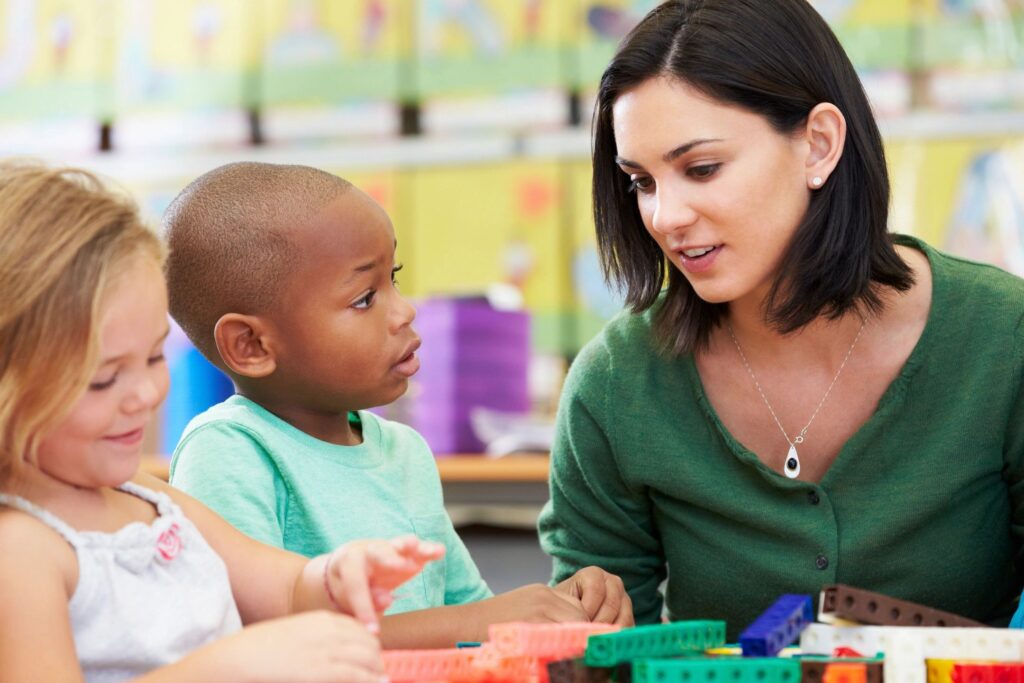Differentiated instruction is a philosophy of teaching and learning that recognizes and responds to student differences in readiness, interests, and learner profiles. It includes planning, teaching, and arranging the classroom environment to take into account each child’s unique needs and interests.
Differentiating learning for young children keeps them engaged in their learning, scaffolds individual needs, and develops their identity as successful learners. Early Childhood Educators (ECEs) may be a child’s first teacher outside the home, contributing to their positive sense of identity as learners and laying the groundwork for their future success as students. As ECEs, we want each child to maintain their natural curiosity, feel confident as learners, and trust the adults in their lives to support their learning.

ECEs typically know their students very well, an essential first step to differentiated instruction. However, since young children change and develop quickly, this can be a challenge for ECEs. A child’s needs in September may differ from what they need a few months (or even weeks) later. In addition, learning is not linear, and children will have different needs on different days. When meeting each child’s needs, a teacher uses all the tools in their toolbox. The challenge is picking and choosing the right tool for each child at the right moment.
Here are six processes that can help ECEs structure differentiated instruction for their students.
1. Assessment
Knowing where the children are in their learning is necessary before you can plan how to support them and the next steps. Some Early Childhood Centers include assessments as part of their program, and some do not. As teachers, one of the best assessment tools is the ability to observe the children in your class. Anecdotal Observations are a great tool for teachers.
Tips for Anecdotal Observation
Choose a method to take brief notes as you observe a child. Notebooks, post-its, index cards, whatever works for you. Jot notes, documenting what you see as if you are describing a picture. Be concrete with enough details to help you plan the next steps. Eliminate evaluative language. For example, let us take the scenario of a child building with blocks. “The child is on task” doesn’t describe a behavior. However, “A student sat in the block area and stacked X number of colored blocks vertically while narrating her actions to herself. You would jot down some of the words and phrases that you hear. When the blocks fell, the student began again without pausing between tries.” This gives you a lot of information and how to build this child’s learning.
2. Planning
Once you know your learning objective and how are you going to teach, plan a variety of ways that you can teach to provide differentiation. If, for example, the learning objective is observation skills (Scientific Inquiry), differentiation ranges from teaching vocabulary for what they see to developing more complex and descriptive language. A rock becomes a big rock, a grey rock, a big grey rock with lines in it, skills include using their five senses as observation tools and perhaps creating representations of what they observe. Knowing where your students are and how your students best learn tells you where to begin and how to meet each student’s needs.
3. Demonstrating Understanding
Young children’s methods of demonstrating understanding vary greatly, from pointing to using short phrases to using full sentences to representation using paper pencil or three-dimensional objects. Acknowledging how each child demonstrates understanding gives them confidence to share what they know and understand.
4. Flexible Grouping
Flexible grouping of students means that you adjust groups to the learning tasks; in some instances, whole group instruction while at other students will be working in small groups or individually to complete tasks to their levels of readiness, interests, and learning preferences. These groups continuously change and are the opposite of grouping for ability.
5. Environment
A differentiated classroom environment includes a combination of learning centers. Centers are designed to address various interests, energy levels, and types of learning. They include self-directed play, guided play, and direct instruction. Materials are available to children to maximize opportunities for children to choose the materials.
6. Teacher Reflection
Reflection is a crucial part of differentiating for your students. Thinking about what worked and what can be improved informs your next steps. Is what you are seeing your students do divergent from what you expected? What surprised you? What can you build upon? Where might you need to pull back or find a different method of delivery? A journal is a helpful tool for reflecting on your students. It does not have to be formal; this is for you to help you better differentiate for your students.
All of these processes take time, and as you master them, you become more efficient at implementation. If you are new to differentiating learning for students, start with one child.
I’m here to help you create a more inclusive and effective learning environment for all your students.
Elevate your understanding of early childhood education and child development with my engaging preschool education workshops tailored for both teachers and parents. These workshops provide valuable insights, practical strategies, and effective tools to enhance your role in nurturing young minds. Whether you’re an educator or a parent, these sessions aim to empower you with the knowledge and skills essential for fostering a positive learning environment. Dive deeper into the world of preschool education and child development by exploring my workshop offerings. For more valuable content and updates, follow me on Instagram and connect with me on LinkedIn. #EarlyYearsConsult
#EarlyChildhoodEducation #ChildDevelopment #PreschoolWorkshops #EducatorServices #ParentingTips #LearnAndGrow

